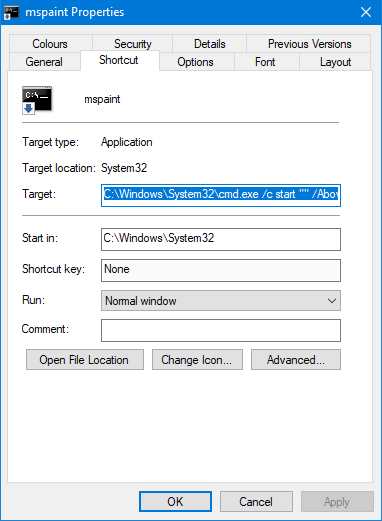Change Process Priority Windows Command Line
You could probably create a.bat file to run the program, use a timeout command to wait a few seconds to let the secondary process run, then use the command below to change the secondary process priority to what you want. Windows Dev Center Dashboard Windows. Scheduling Scheduling Priorities. Of a process and the SetPriorityClass function to change the priority class of a process.
Title says it all, really. I want to have a shortcut on my desktop so I can alter the priority of a process that runs at the normal priority - priority '8' according to Sysinternals's 'Process Explorer'. The process is MsMpEng.exe - MS's Security Essentials. The reason why I want to do this is because currently it uses 95+% CPU time while it's doing it's daily scan - no big deal, I can have a cup of tea - but it also pops up at many other times, while I am copying files or doing other things. That is where it bugs me. Here are some recent Google results from people with the same CPU usage problem: I have added everything I can think of to MSE's Settings 'Excluded Files and Locations' and 'Excluded Processes'.
What I now do, is to lower its priority to 4 using Process Explorer. But that takes many left and right clicks to achieve. I have written a command file that kills MsMpEng.exe and msseces.exe, and starts msseces.exe at a low priority.
But I can't find a way of starting MsMpEng.exe at a low priority. To kill them, I use these commands: >taskkill /f /im MsMpEng.exe >taskkill /f /im msseces.exe To run msseces.exe, I use: >c: >cd ' Program Files Microsoft Security Essentials' >start /Low msseces.exe This will start msseces at priority 4. But the equivalent for MsMpEng does not work: >start /Low MsMpEng.exe In fact, I could not get it to start it all until I noticed an error message calling it a 'service'. So then I found out how to start services, and this worked: >net start 'Microsoft Antimalware Service' These messages were displayed: 'The Microsoft Antimalware Service service is starting. The Microsoft Antimalware Service service was started successfully.' However, I cannot get it to start at low priority.

Sprinkling '/low' in different places on the command line doesn't work. So, can anyone offer a solution that allows me to either: a. Start a service at low priority, or b. Use a utility to change the priority (once it is running) from a command line. Many thanks in advance if you can help. Start Task Manager.
Right click on the process you wish to manage. Select 'Set Priority'. Click on the priority you wish. JoeSorry Joe, did you miss the bit about 'command line utility'? What you suggest is similar to what I do now, but I use Process Explorer to do it. If I had a utility that accepts command line input, I could run it at any time - including at startup - and set the priority straight away so I wouldn't have to worry about it. So you see, I'm very lazy and want these MSE processes de-prioritised as soon as the computer starts.
If you have a multi-core processor, chances are good that on the Performance tab in, you have noticed that the CPU Usage History graphs look about the same for each core, as shown in Figure A. The reason for this is that most applications you run these days have been designed with multi-core processors in mind and will work with the operating system to distribute their operations as evenly as possible across all the available cores. Download Game Billiard Offline Untuk Komputer Gratis. Figure A In most cases, you'll notice that the CPU Usage History graphs look about the same for each core. In most cases this even distribution provides you with the best performance possible. However, that's not always going to be the case. For instance, older applications that were designed for single-core processors can behave irrationally — they may all of a sudden begin maxing out the CPU usage at 100 percent and appear to be locked up.
